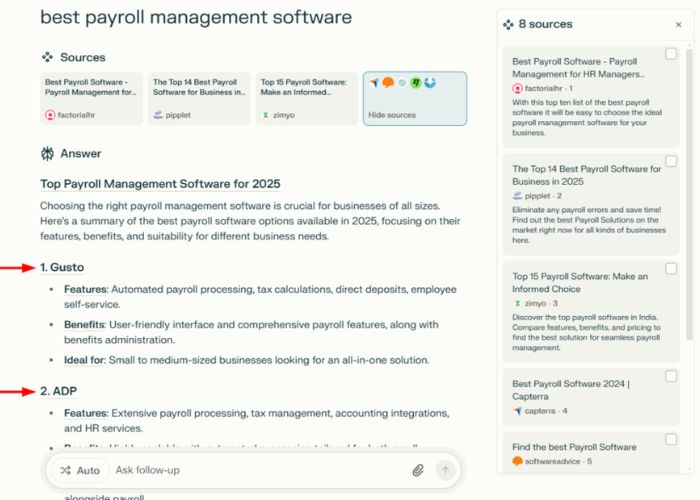Search has changed dramatically by 2025. The SEO Technology Environment is now driven by AI, machine learning, and user-first experiences. Modern search engines deliver instant answers and personalized results, reducing traditional click-through rates. In this new landscape, content strategy matters more than ever. SEO pros and business owners must focus on user intent, high-quality content, and the right tools to stay visible. The rise of Google’s Search Generative Experience (SGE), voice assistants, and visual search means optimizing for answers and experiences, not just keywords. Below, we outline the key trends, tools, and practical tips for content-driven SEO in 2025.
Focus on Intent, Context, and Quality Over Keywords
1. Prioritize user intent:
Modern SEO is about meeting search intent, not keyword stuffing. Identify what the user wants (informational, navigational, transactional, etc.) and create content that answers their question fully. For example, a blog post about “best CRM software” should address small-business use cases if that’s the search intent, not just list features.
2. Use semantic content clusters:
Search engines now analyze context and relationships between topics. Organize your site into topic clusters with interlinked pages. Cover subtopics and FAQs around a main theme. This signals topical authority and helps AI-driven search understand your content’s relevance.
3. Demonstrate expertise (E-E-A-T):
Google values Experience, Expertise, Authoritativeness, and Trustworthiness. Include author bios and cite credentials, link to reputable sources, and publish original research or data. High-quality, in-depth content builds trust and tends to rank better when AI filters out generic or shallow pages.
4. Tools for alignment:
Use AI-powered content tools (Surfer SEO, Frase, MarketMuse) to analyze top-ranking pages and semantic keywords. These tools help optimize your drafts to cover related concepts and match user intent. For example, Google’s new SGE query insights or Surfer’s content editor can suggest relevant questions to answer or keywords to include.
AI and Generative Search: Google SGE, Bing Chat, and More
The search results page is no longer just a list of links. Google SGE and Bing Chat leverage AI to provide direct summaries or conversational answers. For example, Google’s Search Generative Experience generates an AI-powered answer box that summarizes information from multiple sites. Chatbot-based search engines similarly produce concise answer pages instead of traditional SERPs.

1. Optimize for snippets and Q&A:
To be featured in an AI answer, format content with clear questions and answers. Use FAQ or Q&A sections on pages, or start sections with a question (e.g., “What is the best payroll software for 2025?”) followed by a concise answer. Structured data (FAQ/HowTo schema) can help search engines extract and display your content in generative results.
2. Structured content:
AI-driven search relies on well-organized content. Use bullet points, tables, and headings so that an algorithm can easily parse and quote your page. Write clear, factual answers at the top of your content (like a featured snippet) before diving into details.
3. Brand presence matters:
Many AI answers include a “Sources” or list of related articles. Even if AI provides the answer, being cited exposes your brand to the user. Encourage direct brand searches by building your reputation (e.g., through backlinks and thought leadership) so that users recognize and seek out your site.
4. Tools and experimentation:
Use Google’s SGE (in Search Labs) or tools like ChatGPT and Perplexity to test search queries. See how AI answers your own questions and adjust content accordingly. If an AI bot pulls an answer from one of your pages, you’re likely doing something right. If not, refine your phrasing and structure so your key points stand out.
Voice Search and Conversational Queries
Voice assistants (Siri, Alexa, Google Assistant) are ubiquitous in homes and on phones. About 50–60% of people now use voice search regularly. This changes SEO in several ways:
1. Natural language and long-tail phrases:
People talk, they don’t type fragments. Optimize content for conversational queries. For example, include full-sentence questions and answers like “How do I fix [problem]?” instead of just keywords. Aim to match the actual spoken query.
2. Local and transactional focus:
Over half of voice searches are for local information (e.g., “near me” queries) or purchases. Keep your Google Business Profile (GBP) up-to-date with hours, address, and category. Encourage customers to leave reviews on Google and Yelp – voice assistants often read reviews aloud. Also ensure your site has Location schema and up-to-date NAP (Name, Address, Phone) info.
3. Schema markup:
Implement FAQ, HowTo, and LocalBusiness schema. This structured data makes it easier for voice assistants to pull direct answers from your site. For example, a recipe site could use HowTo schema so that an assistant can walk a user through steps.
4. Mobile speed and UX:
Most voice searches happen on mobile. A fast, mobile-responsive site is crucial. Improve page load times (use AMP, optimize images) and minimize friction (clear CTAs, easy navigation). Core Web Vitals (loading speed, interactivity, stability) still matter for ranking.
5. Voice commerce:
Voice devices are increasingly used for shopping and ordering. Optimize product pages with clear, structured descriptions and integrate smooth voice-enabled checkout experiences. For example, include explicit product attributes (size, price, availability) in markup so voice assistants can answer shopping queries accurately.
Visual, Video, and Multimodal Search
Users now search with images and videos as well as text. Google Lens, Pinterest Lens, TikTok, and YouTube are all becoming search tools in their own right.
1. Image search and “lens” search:
Optimize images by using descriptive file names and detailed alt text. Google’s Lens will be able to match objects in photos to your images. For instance, an e-commerce store should label product images with precise descriptions (e.g. “red-leather-mens-sneakers.jpg” with corresponding alt text). This improves discoverability when users search by image or through visual assistants.
2. Video content:
By 2025, most web traffic will be video-driven. Platforms like YouTube (and even Instagram Reels or TikTok) function as search engines for how-to’s, demos, and entertainment. Create short, informative videos and optimize titles, descriptions, and tags with relevant keywords. Include transcripts or captions (this text can be indexed) and add VideoObject schema on your pages.
3. Multimodal search:
Search engines are blending voice, image, and text inputs. For example, a user might take a photo of a product and ask, “Where can I buy this?”. This trend means you need to optimize across formats. Ensure your content is accessible in multiple media (text articles, images, videos, etc.) and consider how each format can answer user queries. For example, an infographic with embedded metadata or a video with a clear spoken answer can serve multimodal search.
4. Social as search:
Platforms like TikTok Shop and Instagram’s shopping feature integrate discovery and purchase. Having shoppable posts on these platforms means a user can find and buy your products without ever using Google. For brands, this means optimizing your social content: use relevant hashtags, clear product tags, and concise copy. Viral short videos can double as SEO if they rank within the app’s internal search.
Leveraging AI Content Tools
AI writing assistants are now key parts of many content workflows. Tools like ChatGPT, Jasper AI, Writesonic, and Copy.ai can generate drafts, outlines, and ideas in seconds. They help save time on brainstorming and initial writing. For example, ChatGPT can suggest headings or write a first draft, which you then polish.
However, human oversight is essential. Use AI for speed and idea generation, but always refine the output for accuracy, tone, and brand voice. Ensure factual correctness and add original insights. For instance, you might ask an AI tool to draft a blog outline, then fill it out with your expertise and data. Combining AI efficiency with human creativity produces the best results.
Integrate AI with SEO tools: for example, Surfer SEO or Frase can take an AI-generated draft and show how to better match the top-ranking pages. Tools like Clearscope or MarketMuse use AI to recommend related keywords or topics your draft should include.
Local SEO and Hyper-Personalization
Local and personalized search are more important than ever. Google’s algorithms now reward tailored experiences.
1. Optimize for local:
Keep your Google Business Profile (GBP) fresh – include up-to-date hours, photos, and services. Use localized keywords (e.g. “vegan pizza in [Neighborhood]”) in your content. Consider creating location-specific landing pages or blog posts targeting regional queries. Ensure NAP data (Name, Address, Phone) is consistent across all directories.
2. Encourage reviews:
Positive online reviews (Google, Yelp, industry sites) boost both trust and local rankings. Ask satisfied customers to leave feedback, and respond to reviews promptly.
3. First-party data & personalization:
AI search is increasingly personalized. Leverage your customer data to tailor experiences. Use dynamic content (e.g. personalized product recommendations based on past behavior), newsletters segmented by interest, or remarketing. The more you adapt content to user intent and history, the more relevant your results will be.
Future-Proofing Your SEO Strategy
SEO is not a one-time effort—it’s an ongoing process. With the pace of change, staying ahead means being proactive.
1. Stay updated:
Follow industry leaders, blogs, and official updates from Google Search Central. Join SEO communities like SEO Signals Lab or Moz Community.
2. Test and measure:
Regularly test new formats (e.g., video summaries, interactive content) and measure how users engage. Double down on what works.
3. Focus on branding:
Google increasingly favors recognizable, trusted brands. Build your brand through consistent messaging, strong design, and expert content.
4. Invest in learning:
As AI and search evolve, continuous education is critical. Attend webinars, take SEO courses, and train your team on emerging tools and tactics.
Key Tools and Platforms
To stay competitive in 2025, make use of these categories of tools:
1. Analytics & Research:
Google Analytics and Google Search Console remain fundamentals for tracking traffic, queries, and site performance. For keyword and competitive research, tools like Ahrefs, SEMrush, and Moz are still vital.
2. Content Optimization:
AI-powered content tools (Surfer SEO, Frase, Clearscope) analyze search intent and suggest changes to improve on-page SEO. They can integrate with Google Docs or WordPress.
3. Site Audit & Technical:
Even though we focus on content, basic technical health is still needed. Use tools like Screaming Frog or Sitebulb to find crawl issues, broken links, or indexation problems. Also, use schema markup generators for FAQs, products, and videos.
4. SEO Platforms:
WordPress plugins (Yoast SEO, Rank Math) help with on-page optimization and schema. E-commerce platforms have their SEO plugins (e.g., Shopify’s SEO tools).
5. Future-focused:
Experiment with AI SEO agents or answer engines like ChatGPT and Perplexity as “new SERPs” to test if your content appears in AI answers.
Conclusion
The SEO Technology Environment in 2025 is more advanced and fast-paced than ever before. Success now depends on more than just keywords or backlinks—it requires a deep understanding of user intent, the smart use of AI tools, and content that delivers real value. As search engines evolve to prioritize relevance, personalization, and multimedia formats, SEO professionals and business owners must stay proactive. By embracing the latest technologies, testing new strategies, and focusing on meaningful content, you can stay competitive and thrive in this rapidly changing SEO Technology Environment.
At The Techno Tricks, we believe staying informed and adapting early is the key to long-term SEO success. Follow us for the latest trends, insights, and tools to stay ahead of the curve.

